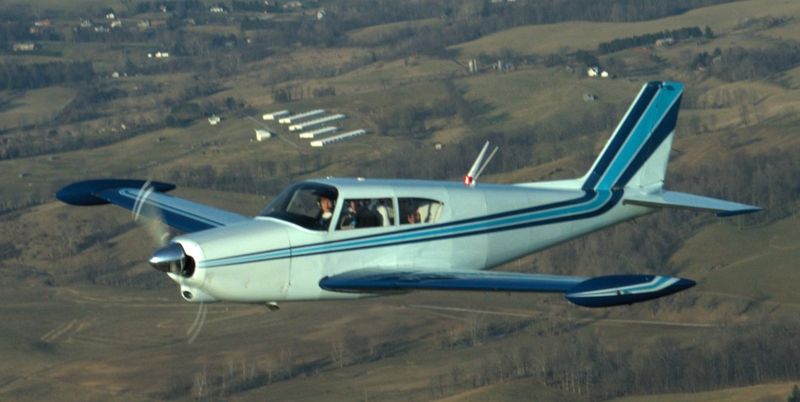

The flaps were manually actuated, controlled by the same Johnson bar actuator as the Piper Cherokee. The standard fuel capacity of the PA-24-180 was 60 US gallons (230 L). The remainder of this production run were given the PA-24-180 designation. The initial production run of the 180 hp (130 kW) Comanche singles were given the PA-24 type designation. Designed by Howard "Pug" Piper, the new Comanche was intended to compete in the market with the very successful Beechcraft Bonanza. PA-24-180 Comanche 180: The original version of the Comanche was the PA-24, which featured a carbureted 180 hp (134 kW) Lycoming O-360-A1A engine, swept tail, laminar flow airfoil, and all-flying stabilator. The self-described junior member of the completion team was Chuck Suma, who 30 years later would become the CEO of The New Piper Aircraft, Inc. After the Susquehanna River receded, Piper moved the last aircraft to Vero Beach and completed construction there. The Comanche production run ended with the disposal of all of the tooling, and completion of the last seven airframes. The Arrow was a retractable gear version of the popular Cherokee trainer its smaller 200 horsepower (150 kW) engine was less expensive and easier to fly than the Comanche sales of the single engine Comanche had faltered after the introduction of the Arrow in 1967. Rather than re-build the tooling, Piper chose to abandon production of the Comanche and Twin Comanche, and continue with two newer designs already in production at Piper's other plant in Vero Beach, Florida: the twin engine PA-34 Seneca and the PA-28R-200 Arrow.Īt that time Piper had already begun to concentrate on its successful Piper PA-28 Cherokee line, which had originally been conceived as a cheaper alternative to the Comanche. Production of the Comanche ended in 1972 when torrential rains from Hurricane Agnes caused the great Susquehanna River flood of 1972, flooding the manufacturing plant and destroying airframes, parts, and much of the tooling necessary for production. The 260 was also available as the Turbo Comanche C with a Rajay turbocharger and was introduced in 1970. The following year, the PA-24-250 was superseded by the PA-24-260, featuring the Lycoming IO-540D or E engine of 260 hp (194 kW). The PA-24-250 model was added in 1958, powered by a Lycoming O-540-A1A5 engine. Together with the Twin Comanche, it made up the core of the Piper Aircraft line-up until 1972, when the production lines for both aircraft were wiped out in a flood.Ĭomanche production began in 1957 with the PA-24-180 model. The Piper PA-24 Comanche is a four-seat, low-wing, all-metal, light aircraft of monocoque construction with retractable landing gear that was first flown in May 1956 according to a Piper Aircraft Company press release. Variants: Piper PA-30 Twin Comanche, Piper PA-39 Twin Comanche.Primary users: Private aviators and Flight schools.Piper PA-24-250 Comanche (N6240P, s/n 24-1345, 1959) c.1994 at the MCAS El Toro Airshow, MCAS El Toro, California (John Shupek photo) Single-engine four-seat low-wing cabin monoplane See what a new Top Prop performance propeller conversion can do to make it even better.Piper PA-24-250 Comanche four-seat low-wing cabin monoplane Piper Aircraft has always offered some of the best aviation values in the sky. Many of these conversions, like the recently approved Aztec and Seminole 2-blade conversion kits, feature the latest in blended airfoil, scimitar technology for the very best performance with added noise reduction. Hartzell also offers 3-blade conversions for most constant speed equipped Piper singles and light twins.
#PIPER COMANCHE UPGRADE#
Hartzell’s Top Prop program builds on this symbiotic relationship by offering the same proven structural composite propeller as an after-market upgrade for earlier Mirage aircraft. Today, Hartzell propellers equip the entire prestigious Piper “M Class” with 4-blade aluminum on the turbine powered Meridian, and an ASC-II advanced structural composite 3-blade scimitar on the Mirage/Matrix models. Since the introduction of the Comanche and Apache in the mid 1950s, Hartzell propellers have been standard equipment on most of Piper’s product lines. Piper Aircraft has been one of the most successful and prolific aircraft builders in the history of general aviation. Few pilots can say that they have never flown a Piper built airplane.


 0 kommentar(er)
0 kommentar(er)
